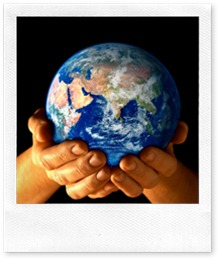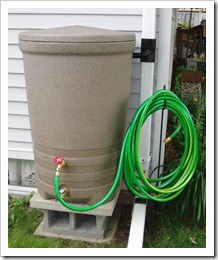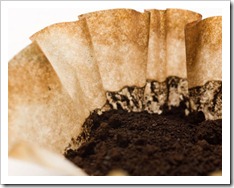Ten Things You Can Do to Make Earth Day Every Day
Today is Earth Day, and while I think it is important to do good things to help the Earth, these efforts and thoughts behind them would be better served every day of the year!
When we were kids, my brother and I would save up all the printer paper in the house (yes, the kind with holes on the side) and take it to school to recycle. That was my first foray into this idea of “reduce, reuse, recycle,” and it is a mantra that has stuck with me ever since.
I’m lucky enough to live in a place where conservation is a mindset that is more the norm than the exception, and opportunities to do right by Mother Earth abound. Would you believe that we only “throw away” about two grocery sized bags of trash each month? I’m talking about the little sacks you get at the grocery store if you don’t bring your own bags! (But, you bring your own bags right? I thought so.)
I thought I’d share some of my tips and tricks for conservation. The cumulative effect of each person’s actions can make a real difference!
Make Earth Day Every Day
1. Recycle! It sounds so trite to say, but, such a large portion of your household items can be recycled – it just may take a small bit of effort to do said recycling. Luckily, our curbside recycling program from Waste Management takes an amazing variety of items, from small electronics to all manners of paper and plastics and even plastic bags. If you aren’t so fortunate, you may have to save up certain items and take them to places that recycle those items. For example:
Whole Foods Market recycles:
- CFL Bulbs
- Non-re-chargeable (alkaline) batteries
- Wine bottle corks
- Plastic Bags
- #5 plastics (think reusable containers like Ziploc, etc., and yogurt containers)
- Cell phones
- And more, depending on location
Best Buy recycles:
- Re-chargeable batteries
- Used printer cartridges
- Cell Phones
- And, just about anything electronic (TVs, printers, monitors, cables, etc.) – you just have to ask
We take items like paint and chemicals to our solid waste transfer station (AKA, the dump), where they are recycled for free.
This list is not exhaustive, of course, and stores in your area have individual items they recycle. For instance, we take our Lithium Ion batteries to Radio Shack and old eyeglasses to LensCrafters. A quick Bing or Google search for the item you are trying to recycle and your location will no doubt bring up multiple options. It is worth just a quick search – you may be surprised to find it’s easier to recycle whatever that mystery item is than you thought.
2. Catch Rainwater. The power of this one is 
You just need about 1/2” of rain to fill a 50-gallon rain barrel! Just be sure to put the barrel on a raised platform so gravity can do the work for you and provide water pressure. Good ones have a flat back so they can snuggle right up to your house, as well as a filter to keep leaves and debris out of the water. (This picture is not our house – it’s from the Amazon listing for the rain barrel.)
3. Compost. We keep a 14 lb plastic kitty litter container (without litter, of course) that has a lid under our kitchen sink to collect food scraps and transfer it to our yard waste bin every few days. We’re lucky in that Waste Management in our area wants food scraps in with the yard waste to help with the composting process. But, if you don’t have such a luxury, you can make DIY compost if you have a little bit of spare land. And, if you’re really clever, you can make veggie broth out of your veggie scraps before they hit the compost bin. That is a win-win!
4. Donate. 2Chili and I have done two full-gut remodels (and we still speak!). In the process, we have donated a wide range of building materials, from windows and doors to lumber, to bricks, and even broken up concrete. We have given away items on Craigslist, dropped off at building material recycling centers, and even traded items we don’t want for items we do.
We try our best to make sure the only items that hit the landfills are actually trash. But, in the process of visiting the solid waste transfer center, we have seen amazing amounts of perfectly good stuff thrown in to the dumpsters. We’ve seen upright pianos, kids’ bikes, furniture, yard tools, and the list goes on and on, just tossed into trailers that will be hauled off and buried in Eastern Washington.
Don’t pay to throw away perfectly good stuff! You can donate many household items, from clothes and shoes to furniture and bedding to sporting goods and tools at many places:
- Goodwill
- The Salvation Army
- Habitat for Humanity
- Your local church, community center, and schools often take in-kind donations of usable items
- For those in the Seattle area, Northwest Center does curbside pick ups every so often – couldn’t be easier than that
5. Buy non-toxic cleaning products. It’s easy to not think about the downstream
My favorites come from Method and Seventh Generation.
6. If you have a pet, bag their waste in a biodegradable bag. One day it occurred to me that I was taking the most degradable item there really is and bagging it up in bags that would not degrade. Talk about a moment of clarity. Since then, I have bagged cat and dog waste in degradable plastic. I don’t use one bag per day – I try to get 3-4 days worth of “production” into one bag to stretch pennies.
7. Buy a programmable thermostat and keep your house/apartment at a constant temperature. Large temperature swings (be they hot or cold) take a lot of energy for your furnace or air conditioner to make up for. It is far more energy efficient to keep your place at an even temperature. We don’t have an air conditioner (I know! they’re uncommon in the NW), but we set our furnace to 65 degrees during the day in winter, and 60 degrees overnight. We have found those temperatures work for us – we prefer it slightly cooler at night. Our power bill is constant and predictable, and we never worry about setting the thermostat – it’s programmed just how we like it. You don’t have to spend a lot – here is one for less than $25.
8. Consolidate trips when you can. I am admittedly lucky and spoiled. I work from home, and only go to client meetings once, or twice a week, tops. But, when I do leave the house, I try to perform multiple tasks at once if at all possible. It saves time, money, and fossil fuels!
9. Procure some re-useable bags. Okay, I really didn’t need to tell you this, but reusable bags are a no brainer! There are even some that are biodegradable, so when they wear out, they will decompose if you toss ‘em out.
On the topic of bags, It is also worth noting that not just plastic grocery bags are recyclable. Pretty much any thin plastic bags, like the ones that dried beans come in, are recyclable along with your plastic bags. So, save all your thin plastic bags (they will usually have a #2 or #4 recycling emblem on them) and take them to your grocery store, Home Depot or any other store that recycles bags. Here is a nice tutorial on the topic.
10. Fertilize your garden with coffee and tea grounds, as well as “veggie water,” and kill weeds with boiling water. Did you know you can fertilize your plants with simple things like coffee and tea grounds? It works amazingly well, and you can get the grounds for free at Starbucks if you don’t have your own. I once grabbed a bag of grounds while leaving coffee with a friend and she thought I was stealing coffee! Not at all. In fact, they want you to take the grounds, as it helps them reduce their overall waste footprint as well. And, coffee grounds help repel snails- really! (Image source.)
I wrote a post a while back about using leftover veggie water as a fertilizer as well. It works like a champ, and has no chemicals! I love this method. Just remember to always cool the water before you pour it on any plants. Hot water kills plants! And, weeds. So, if you want a low chemical weed killer, boil some water in your tea kettle and pour it over the weeds. This works really well on dandelions, which start to rear their pretty little flowered heads this time of year.
And, there you have it. My ten tips for living like it’s Earth Day every day. I hope you found some useful tips in there. I have many more, but, will save those for another day.
Have a great weekend!





